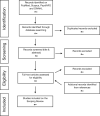Etiology of gender incongruence and its levels of evidence: A scoping review protocol
- PMID: 36913426
- PMCID: PMC10010510
- DOI: 10.1371/journal.pone.0283011
Etiology of gender incongruence and its levels of evidence: A scoping review protocol
Abstract
Introduction: Gender Incongruence refers to the discordance between biological sex and gender identity. Although it is possible to find literature reviews about the etiology of Gender Incongruence, almost all of these correspond to non-systematic narrative reviews, so they do not make explicit the methodology used in the collection and analysis of sources, even less its levels of evidence. In order to remedy this, we will conduct a scoping review to answer the question: what are the factors associated with gender incongruence and what level of evidence is there for each factor in the scientific literature?
Methods and analysis: We will conduct a scoping review according to the methodology specified in the JBI Manual for Evidence Synthesis (Chapter 11) and the PRISMA extension for scoping reviews (PRISMA-ScR). Four databases will be reviewed to identify papers that match our search criteria, followed by a screening of titles and abstracts, the complete reading of those articles that have not been excluded, and the coding of these using the data extraction instrument developed for this research (see S1 Appendix). Data extracted will be analyzed in terms of frequency counts of factors, types of factors and levels of evidence for each factor. Results will be presented in tabular or diagrammatic forms supported by a narrative summary.
Findings: The present review will help to map the factors associated with incongruence between biological sex and gender identity, specifying their levels of evidence. This evidence-based knowledge will be useful for clinicians evaluating gender incongruence, especially given that international guidelines recommend careful assessment of factors that may interfere with the clarity of gender identity development and decision making.
Copyright: © 2023 Rojas Saffie, Eyzaguirre Bäuerle. This is an open access article distributed under the terms of the Creative Commons Attribution License, which permits unrestricted use, distribution, and reproduction in any medium, provided the original author and source are credited.
Conflict of interest statement
The authors have declared that no competing interests exist.
References
-
- Hirschfeld M. Die intersexuelle konstitution. Jahrbuch für Sexuelle Zwischenstufen. 1923;(23):3–27.
-
- Hirschfeld M. Geschlechtskunde (Vol. 4). Stuttgart: Julius Püttmann.; 1930.
-
- Mas Grau J. Del transexualismo a la disforia de género en el DSM. Cambios terminológicos, misma esencia patologizante. Rev int sociol. 2017. May 24;75(2):e059.
MeSH terms
LinkOut - more resources
Full Text Sources


